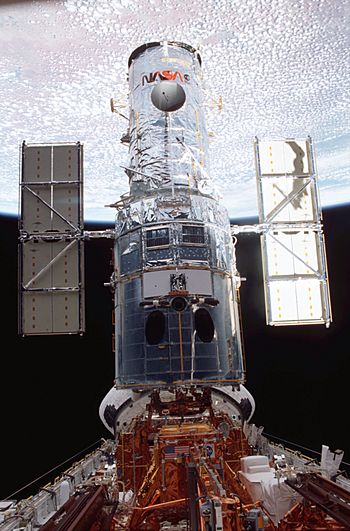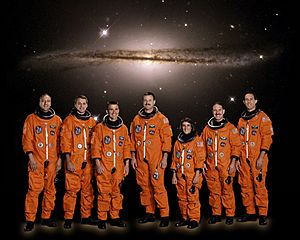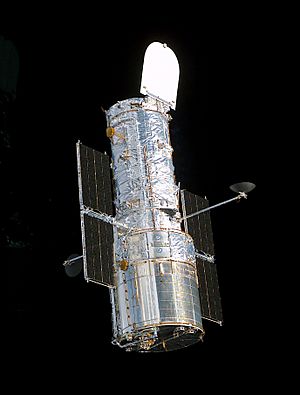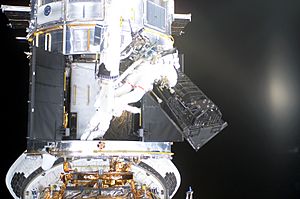STS-109 facts for kids

The Hubble Space Telescope in Columbia's payload bay towards the end of the mission
|
|
| Mission type | Hubble servicing |
|---|---|
| Operator | NASA |
| Mission duration | 10 days, 22 hours, 11 minutes, 09 seconds |
| Distance travelled | 6,300,000 kilometres (3,900,000 mi) |
| Orbits completed | 165 |
| Spacecraft properties | |
| Spacecraft | Space Shuttle Columbia |
| Launch mass | 116,989 kg (257,917 lb) |
| Landing mass | 100,564 kg (221,706 lb) |
| Crew | |
| Crew size | 7 |
| Members |
|
| Start of mission | |
| Launch date | 1 March 2002 11:22:02 UTC |
| Launch site | Kennedy LC-39A |
| End of mission | |
| Landing date | 12 March 2002 09:33:10 UTC |
| Landing site | Kennedy SLF Runway 33 |
| Orbital parameters | |
| Reference system | Geocentric |
| Regime | Low Earth |
| Perigee | 486 km (302 mi) |
| Apogee | 578 km (359 mi) |
| Inclination | 28.5 degrees |
| Period | 95.3 minutes |
  (L-R): Michael J. Massimino, Richard M. Linnehan, Duane G. Carey, Scott D. Altman, Nancy J. Currie, John M. Grunsfeld and James H. Newman. |
|
STS-109 was a Space Shuttle mission launched by NASA on March 1, 2002. It was the 108th mission in the Space Shuttle program. This flight was the 27th time the orbiter Columbia flew into space.
The main goal of STS-109 was to service the Hubble Space Telescope. This was the fourth time astronauts visited Hubble to make repairs and upgrades. The Hubble Space Telescope was first put into orbit in 1990 during mission STS-31. It was designed to work for 15 years, but with regular check-ups and new parts, it has lasted much longer!
This mission was also the last successful flight for the Space Shuttle Columbia. On its very next mission, STS-107, the shuttle faced a serious problem during its return to Earth, and sadly, all astronauts on board were lost.
Contents
Meet the Astronauts: STS-109 Crew
The STS-109 mission had a crew of seven brave astronauts. They worked together to complete the important tasks needed to fix and upgrade the Hubble Space Telescope.
| Position | Astronaut | |
|---|---|---|
| Commander | Scott D. Altman Third spaceflight |
|
| Pilot | Duane G. Carey Only spaceflight |
|
| Mission Specialist 1 | John M. Grunsfeld Fourth spaceflight |
|
| Mission Specialist 2 | Nancy J. Currie Fourth and last spaceflight |
|
| Mission Specialist 3 | Richard M. Linnehan Third spaceflight |
|
| Mission Specialist 4 | James H. Newman Fourth and last spaceflight |
|
| Mission Specialist 5 | Michael J. Massimino First spaceflight |
|
Spacewalks for Hubble Repair
During the STS-109 mission, astronauts performed five spacewalks, also known as Extravehicular Activities (EVAs). These spacewalks were crucial for repairing and upgrading the Hubble Space Telescope. Each spacewalk lasted several hours, allowing the astronauts to work directly on the telescope in space.
| EVA | Team | Start – UTC | End – UTC | Duration |
|---|---|---|---|---|
| 1 | Grunsfeld Linnehan |
4 March 2002, 06:37 | 4 March 2002, 13:38 | 7:01 |
| 2 | Newman Massimino |
5 March 2002, 06:40 | 5 March 2002, 13:56 | 7:16 |
| 3 | Grunsfeld Linnehan |
6 March 2002, 08:28 | 6 March 2002, 15:16 | 6:48 |
| 4 | Newman Massimino |
7 March 2002, 09:00 | 7 March 2002, 16:18 | 7:18 |
| 5 | Grunsfeld Linnehan |
8 March 2002, 08:46 | 8 March 2002, 16:18 | 7:32 |
Key Moments of the Mission

The STS-109 mission was all about giving the Hubble Space Telescope a major tune-up. This was the first flight for Columbia after a long period of upgrades and maintenance.
During the mission, the crew installed several new parts on Hubble:
- A new science instrument called the Advanced Camera for Surveys (ACS). This camera helps Hubble take even better pictures of space.
- New, stronger solar arrays (SA3). These are like the telescope's wings, collecting sunlight to power it.
- A new Power Control Unit (PCU). This unit helps manage all the electricity flowing through Hubble.
- An experimental cooling system for the Near Infrared Camera and Multi-Object Spectrometer (NICMOS). This cooler helps a special camera see in infrared light.
Columbia also gave Hubble a "boost" to a higher orbit. This helps keep the telescope from slowly falling back towards Earth.
The astronauts performed five spacewalks on five days in a row to do all this work. Their crewmates inside Columbia helped them. Nancy Currie operated the Shuttle's robot arm, guiding the astronauts and equipment. The other crew members took videos and photos of the spacewalks.
In total, the astronauts spent over 35 hours outside the shuttle during these spacewalks. This mission was a huge success for keeping the Hubble Space Telescope working well for many more years.
The launch of STS-109 happened early in the morning, about 25 minutes before sunrise. This made it a "night launch," which can be a spectacular sight!
Images for kids
-
(L-R): Michael J. Massimino, Richard M. Linnehan, Duane G. Carey, Scott D. Altman, Nancy J. Currie, John M. Grunsfeld and James H. Newman.
See also
 In Spanish: STS-109 para niños
In Spanish: STS-109 para niños






